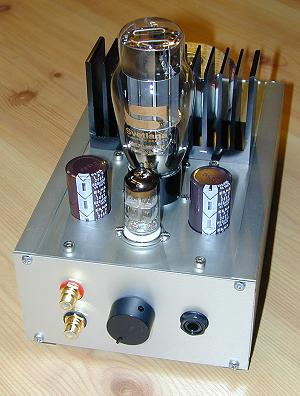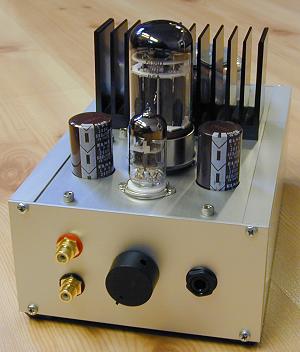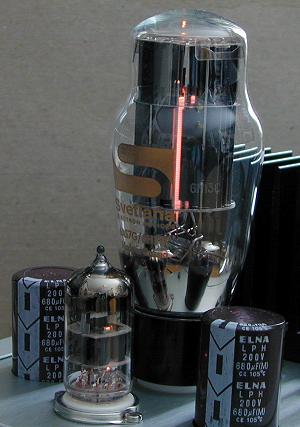 |
The
interior of the amplifier. The audio-circuit is hardwired with prototyping
board as support. The cathode resistors for the output tube are of the new
type in TO220-package (partly visible left of the octal socket). All resistors
in the amplifier circuit are 2W metal-film.
The large capacitor at the left side is the filter cap for the heater regulator.
The regulator itself is bolted to the chassis and a large heatsink mounted
at the top. |
 |
This
is the high-voltage (150V) power supply unit. The upper, smaller board is
the high-voltage regulator with slow-start (that replaces the choke). |
 |
Choose
your tube - a Svetlana 6AS7G or a 6080WC from Philips ECG (made in US, military
grade, marked JAN).
The small one is a Sovtek 6922 (E88CC), used in the input stage. Any E88CC/6DJ8/6922
can be used. |
 |
Complete
interior of the amplifier. It looks little bit crowded, but it is rather
spacy due to the box that are rather thick. |
 |
Complete
amplifier, equipped with the Svetlana 6AS7. The visible capasitors are the
680uF used for the output. |
 |
Rear
view of the amplifier. The heatsink is for cooling the heater regulator
and the toroid transformer is for the high-voltage. The heater transformer
is placed inside the box, right under the visible transformer. |
 |
Here is the 6080 used instead. |
 |
Tube porn - a close up of the setup with Svetlana 6AS7G + Sovtek 6922. |
 |
More tube porn - this time the 6080 is in place. |
 |
Here is a picture showing the open design of the 6AS7 electrode architecture.
This tube (and the 6080) is a real glower - a perfect show-off tube. |









